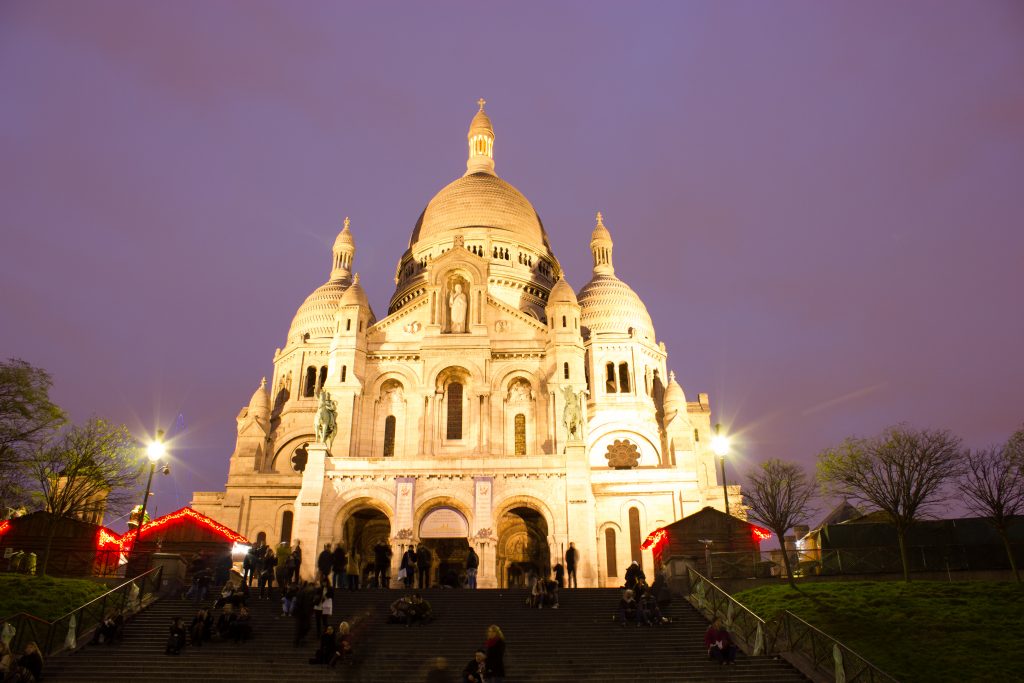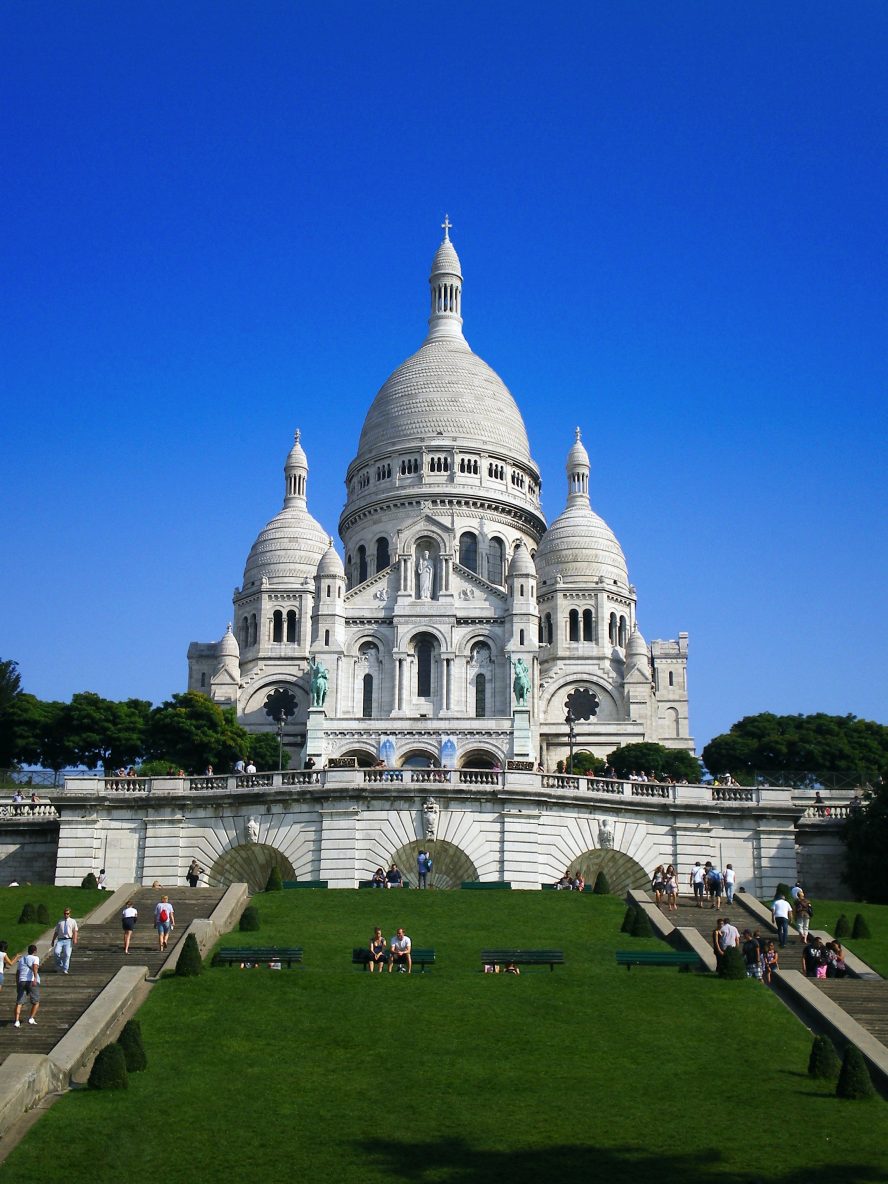 Saint-Denis was personally converted by Saint Paul and, a passionate and very brave man, he took the gospel to the Gauls, becoming the Bishop of Paris in the early 200s AD. He was a dynamic speaker, converting so many Parisiens that the local priests (Roman colonists) were horrified by his success. The complained to the Emperor Decius who became a campaign of persecution so devastating that by the mid 200s there was only a small group of Christians left at a place called Lutetia. Deni with his companions Rusticus and Eleutherius were on one side of the River Seine, the Romans were on the other. Unfazed by the Roman strength and threat, Denis continued to preach and was arrested, tortured and thrown into a cell. After a long imprisonment, he and his companions were taken to the highest hill in Paris – Mons Martis, which was both a Roman and druidic holy place. Part way up the hill, on a grassy knoll, they were executed with steel swords, their heads tumbling from their shoulders to the grass of the mountain.This however, was but a flesh wound for the tenacious Saint-Denis. He bent down, picked up his head and carried it in his arms towards the top of the mountain, all the while preaching a sermon on repentance that touched even the most hardened of Roman soldiers. Carrying one’s own head, hiking several miles AND preaching is exhausting work however and he eventually succumbed to his injuries upon the summit of Mons Martis where he lay and was later buried by those local Christians who had survived the Roman persecution.
Saint-Denis was personally converted by Saint Paul and, a passionate and very brave man, he took the gospel to the Gauls, becoming the Bishop of Paris in the early 200s AD. He was a dynamic speaker, converting so many Parisiens that the local priests (Roman colonists) were horrified by his success. The complained to the Emperor Decius who became a campaign of persecution so devastating that by the mid 200s there was only a small group of Christians left at a place called Lutetia. Deni with his companions Rusticus and Eleutherius were on one side of the River Seine, the Romans were on the other. Unfazed by the Roman strength and threat, Denis continued to preach and was arrested, tortured and thrown into a cell. After a long imprisonment, he and his companions were taken to the highest hill in Paris – Mons Martis, which was both a Roman and druidic holy place. Part way up the hill, on a grassy knoll, they were executed with steel swords, their heads tumbling from their shoulders to the grass of the mountain.This however, was but a flesh wound for the tenacious Saint-Denis. He bent down, picked up his head and carried it in his arms towards the top of the mountain, all the while preaching a sermon on repentance that touched even the most hardened of Roman soldiers. Carrying one’s own head, hiking several miles AND preaching is exhausting work however and he eventually succumbed to his injuries upon the summit of Mons Martis where he lay and was later buried by those local Christians who had survived the Roman persecution.
One woman in particular, Genevieve, was determined to mark the holy spot and built a small chapel over his grave. Over the years this was rebuilt and renovated until it became the Saint Denis Basilica – a burial place for the Kings of France.The mountain – originally named Mons Martis – or The Hill of Mars was cheekily renamed Mons Martyrdom – The Martyrs Mountain – a name that stuck and became the name of the entire arrondissement in Paris – Montmartre. By the 1870s it was clear that Paris was in the grips of some strange chaos. The horror of The Paris Commune, a radical socialist revolution that took government for a mighty seventy-one days, was only overshadowed by the countries defeat in the Franco-Prussian war. The Catholic Church knew what was needed. The cities most rebellious neighbourhood – the ones behind behind the Paris Commune – were the bohemians who inhabited the mountain of Paris – Montmartre. What was needed was a symbol of love, forgiveness and above all – purity. This came in the form of the very white (in face the stones have their own self-bleaching agent which is activated by rain), Basilica of the Sacred Heart of Paris. A huge church covering the entire top of the mountain, including the chapel of Saint-Denis and looking down with both judgment and hope on the city of Paris. Finally finishes in 1914, the Sacre Coeur Basilica is nearly the most famous location in Montmartre.It illuminates the Parisian night almost as brightly as its more famous neighbour – the Moulin Rouge – a venue that regularly makes the still exhausted Saint-Denis consider picking up his head and giving another sermon.Remarque:Denis’ headless wanderings made him a fascinating subject for sculptors, so much so that a name has been given to the many images of him (and other decapitated saints like him) gently cradling his own head – the cephalophore. Of course the conundrum arises – where does one put the halo on a decapitated saint? Around the head? Or where the head should be? There has also been a long-running dispute over who actually owns that glorious talking head. Notre Dame Cathedral claims to have a small piece of the skull, accidentally taken off on the executioner’s first attempt, while Sacre Coeur claims the rest of it. Of course this also made for some interesting artistic decisions – the most politically correct artists show a bishop, holding a scalped head in one hand, and a dislodged halo in the other.

